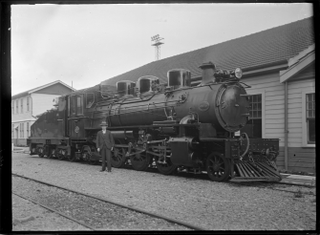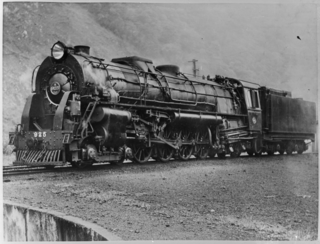
Railway preservation in New Zealand is the preservation of historically significant facets of New Zealand's rail transport history. The earliest recorded preservation attempt took place in 1925, although the movement itself did not start properly until 1960. New Zealand appears to have a higher proportion of organized railway enthusiasts per 1,000 of population than any other part of the world.

The New Zealand F class was the first important class of steam locomotive built to operate on New Zealand's railway network after the national gauge of 3 ft 6 in was adopted. The first locomotives built for the new gauge railways were two E class double Fairlies for the Dunedin and Port Chalmers Railway Company. The F class was the first class ordered by the central government, and between 1872 and 1888, a total of eighty-eight members of the class were constructed.

The NZR WD class was a class of tank locomotive built by Baldwin Locomotive Works to operate on New Zealand's national rail network.

The NZR E class of Double Fairlie steam locomotives were two different types of Fairlie steam locomotives, used on New Zealand's railway network.

The New Zealand X class was a pioneering class of eighteen 4-8-2 steam locomotives built for New Zealand Railways Department (NZR) and designed by A. L. Beattie that operated on the national rail network of New Zealand. In 1908, a heavy and powerful locomotive was required to haul traffic on the newly completed mountainous central section of the North Island Main Trunk Railway, and as a logical progression of the 4-6-2 Q class design, the 4-8-2 wheel arrangement was created for the X class.

The NZR C class consisted of twenty-four steam locomotives built to perform shunting duties on New Zealand's national rail network. It is sometimes known as the big C class to differentiate it from the C class of 1873.

The NZR WAB class locomotives were steam locomotives designed, built and used by New Zealand Railways Department (NZR). Their wheel arrangement is described by the Whyte notation 4-6-4T. The locomotives were designed by NZR chief draughtsman S.H. Jenkinson as tank versions of the AB class 4-6-2 Pacific locomotive. Initially, the locomotives were separated into two classes, designated WAB for mainline work and WS for suburban work.

The NZR JA class were a type of 4-8-2 steam locomotive used on the New Zealand railway network. The class was built in two batches, the first batch was built at Dunedin's Hillside Workshops between 1946 and 1956 and the second batch by the North British Locomotive Works in 1951. To distinguish between the batches, locomotives are identified by their maker.
This is a list of jargon commonly used by railfans and railway employees in New Zealand.

The New Zealand EW class locomotive was a type of electric locomotive used in Wellington, New Zealand. The classification "EW" was due to their being electric locomotives allocated to Wellington. For two decades until the advent of the DX class they were the most powerful locomotives in New Zealand.

The NZR K class of 1932 was a class of mixed traffic 4-8-4 steam locomotives built by the New Zealand Railways Department (NZR) that operated on New Zealand's railway network. The locomotives were developed following the failure of the G class Garratts. The class should not be confused with the much earlier K class of 1877-78, the first American-built engines to arrive in New Zealand.

The NZR G class was a type of Garratt steam locomotive used in New Zealand, later rebuilt as Pacific type locomotives. They were the only Garratt type steam locomotives ever used by the New Zealand Railways (NZR). They were ordered to deal with traffic growth over the heavy gradients of the North Island Main Trunk (NIMT) and to do away with the use of banking engines on steep grades. They were one of the few Garratt designs to employ six cylinders. A mechanical stoker was used to feed coal into the locomotive.

The NZR KA class of 1939 was a class of mixed traffic 4-8-4 steam locomotives that operated on New Zealand's railway network. They were built after the success of the K class to meet the increasing traffic demands of the New Zealand Railways Department. The locomotives first appeared with distinctive streamlining, mainly to hide their ACFI feedwater heater systems.

The NZR EO class of 1923 were electric locomotives used on the steep Otira to Arthurs Pass section of the Midland Line in New Zealand. They were primarily needed for pulling trains through the 1 in 33 grade 8.5 km (5.3 mi) Otira Tunnel which was too long and steep to allow steam locomotives to be used.

The NZR J class steam locomotives were a type of 4-8-2 steam locomotive built for the New Zealand Railways Department (NZR) and used on the New Zealand railway network. Built by the North British Locomotive Works, although designed to work on the lighter secondary lines the class was frequently used on mainline express passenger trains as well as freight. The class first appeared in distinctive streamlining, which was later removed from 1947 onwards for maintenance reasons. The class should not be confused with the earlier 1874 J class. Three J class lasted until the end of steam-hauled services on 26 October 1971, three locomotives of the forty built have been preserved.

The New Zealand DG and DH class locomotive were a type of diesel-electric locomotives in operation on New Zealand's rail network from 1955-1983, built by English Electric.

NZR D class steam tank locomotives operated on New Zealand's national railway network. The first entered service in 1874 all had been withdrawn by the end of 1927, which allowed the D classification to be used again in 1929.

The NZR W class consisted of two steam locomotives built at the Addington Railway Workshops in Christchurch, New Zealand by the New Zealand Railways Department (NZR). They were the first locomotives to be built by NZR.

The NZR EC class was a class of electric locomotive used in Christchurch, New Zealand. They replaced steam locomotives on trains through the Lyttelton rail tunnel between Lyttelton and Christchurch.
The Ferrymead 125 celebration was an event to celebrate 125 years of Rail transport in New Zealand. The event was held over a week from 17 to 24 October 1988, with trains running in, and to and from Christchurch.


















